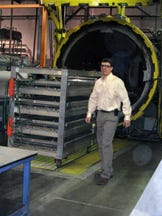November 30, 2009
Composiflex is out to prove that thermoset plastics can lock horns with and add value to some of the most demanding applications on the market today.
The processor of high-performance composites for the medical device, recreational equipment, aerospace, armor/security, ballistics, and military market is seeing high demand in a number of fields, particularly in equipment for hospitals and personal protection sectors, says company president Alan Hannibal. “Even in poor financial times as we have experienced at the beginning of 2009, we are still seeing customers who are investing in product development. We are doing more business in this sector than ever before,” Hannibal says. “This says to us that these customers want to be prepared when the economy is back in full swing.”
|
Composiflex, which next year will expand into a 55,000-ft2 facility at its Erie, PA headquarters, provides a variety of composite processing technologies, including press and autoclave curing, filament winding, vacuum bagging, and resin transfer molding. “Key for us is to offer customers a one-stop shop from design to delivery,” says Hannibal. “Customers today don’t just want delivery of product, but ready-made assembled goods from a single source.”
Epoxy with glass or carbon-fiber reinforcement accounts for much of the material processed at the company. For ballistics and armor plate applications, the company uses aramid fiber such as Twaron from Teijin Aramid. More than 35% of the company’s output is exported. Larry Yaple, engineering manager at Composiflex, says many of the products codeveloped with customers are metal-to-composite transitions, such as a motorcycle fender that, when switched to thermoset plastics, reaped the customer a 40% weight savings.
Two years ago the company brought onto the market a special ballistic shield that maximizes user protection. Hannibal says traditional ballistic shields have smaller view ports with limited visibility; soldiers or law enforcement personnel have difficulty simultaneously viewing and aiming. Composiflex’s HG series of Level IIIA shields includes view ports that run the width of the shield to give a continuous field of view. The units are fabricated using aramid materials and weigh about 17 lb (7.7 kg).
In the medical device sector, the processor works closely with customer GE Healthcare in designing and delivery of patient fixation systems for tables used for diagnostic imaging. The slab tables made of modified Rohacell-brand closed-cell polymethacrylimide (PMI) rigid foam from Evonik Industries are then laid up with carbon fiber skins. “Stiffness is most critical but we are finding that as the population becomes increasingly fatter, strength has turned out to be essential,” Hannibal says. A single medical table generally takes 6-10 hours to produce by hand, followed by 4 hours of autoclave curing.
The company, which started in 1986, has a staff of 65 with a high percentage of women working on the hand lay-up shop floor. “All the fibers are oriented by hand. Our experience has proven that women are better at this job than men because they show patience and exactness to produce a quality product in this sector,” Yaple says. The company also offers contract water jet cutting services.
Although this year has seen about a 40% drop in demand for one of the company’s key products, the FlexPly composite spring, Yaple expects demand to return to high levels when financially strapped companies start investing in production equipment again. The E-glass/epoxy, carbon/epoxy, and high-temperature glass/epoxy springs offer a higher service life and can be a direct replacement for competitive vibrator springs. The future remains bright for composites, reckons Hannibal. —[email protected]
About the Author(s)
You May Also Like



